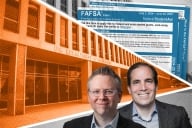You have /5 articles left.
Sign up for a free account or log in.

Ferrum College president Mirta Martin, far left, is leading extraordinary efforts to recruit new students this summer.
Ferrum College
Mirta Martin spent the past two sweltering Saturdays knocking on doors in the greater Roanoke, Va., area, leaving pamphlets on porches and hoping to catch some residents at home for a chat. Two weeks ago she visited 35 homes in one afternoon.
She wasn’t canvassing for a political candidate or selling Bibles; she was recruiting students for Ferrum College, the tiny institution nestled in the Blue Ridge mountains where Martin is the president.
This high-contact recruitment campaign is one of many unorthodox tactics Ferrum is adopting as it struggles to fill seats for the fall after the disastrous rollout of the new Free Application for Federal Student Aid devastated its enrollment outlook. In December the institution was on track to welcome its largest ever incoming class: about 450 students, Martin said. By the summer, that number had dropped under 350.
“Many of our students are unable to commit to affording college without confirmed federal financial aid, so they decided to take a year off,” she said. “The FAFSA disruption has really taken a toll.”
Now Ferrum is working overtime this summer, tapping staff across departments for its door-knocking and phone-canvassing efforts, which target students who applied to or expressed interest in Ferrum but never committed.
“We’ll be doing that for the next four weeks, day by day,” Martin said. “It’s all hands on deck.”
Their emergency measures go much further. Martin said they’ve “flooded the market” with advertisements, and pushed the deposit deadline all the way back to Aug. 26, which is “about as far as we can go,” Martin said.
Ferrum has also stripped its application to the bare essentials: name, date, address and GPA. Even a GPA below Ferrum’s usual 2.75 cutoff won’t be a deal-breaker this year; Martin said the college is planning to admit those who don’t meet the threshold on a “provisional basis” and enroll them in a new academic on-ramp program.
“It’s admissions on the spot,” she said.
On top of it all, Ferrum is offering a $10,000 tuition discount this cycle for both incoming and continuing students, a drastic reduction that Martin admitted was a financial risk, but one that she believes will pay off in the long run. Already Ferrum’s unorthodox campaign is beginning to show dividends: an additional 23 students have made deposits in the past three weeks, Martin said. But the college has a lot more lost ground to make up, and this year’s prolonged uncertainty puts it in a precarious financial spot.
Ferrum is certainly not alone in that regard. John Naughton, vice president for enrollment at Ohio Dominican University, said that despite a 35 percent uptick in applications this cycle, his institution is nearly 15 percent behind last year in student deposits. Because of that, officials remain largely in the dark about their enrollment for the fall.
“Even now, in mid-July, it’s difficult for us to get a clear picture of where we stand in the fall—really, in one month from now,” he said. “We can’t just look at historical data and say, ‘Normally we have this number in July. We’ll melt that number, and that’s where we’ll land.’ That’s all out the window.”
Barbara Mistick, president of the National Association of Independent Colleges and Universities, said that with many of her organization’s member institutions still struggling to meet their all-important enrollment goals, high-contact recruitment and radical solutions have become more common.
“This year is a never-ending admissions cycle,” she said. “Institutions you see bringing in the kinds of classes that they want this fall, it’s going to be thanks to truly herculean efforts.”
But Mistick cautioned that such emergency measures could cause problems for colleges down the line if they stretch already threadbare budgets to the limit.
“Whatever commitments are made this year will have an impact on institutions for several years,” she said. “I worry about that, because the margins are super thin at many of these institutions.”
‘They Need Our Help’
Small, tuition-dependent private colleges with low name recognition have shouldered some of the worst effects of the FAFSA fiasco. Already an endangered species in higher ed, many have turned to layoffs and program cuts to balance budgets after the FAFSA debacle pushed them from shaky financial footing to dire straits.
But Ferrum’s demographics made it particularly vulnerable. Ninety-nine percent of the student body is on some sort of financial aid, 62 percent are first-generation college students and 60 percent are eligible for federal Pell Grants, Martin said.
So when Ferrum launched its own financial aid calculator and guarantee in the spring, it didn’t help shore up enrollment as much as similar forms did at colleges with wealthier demographics.
“Even with [the form], families said, ‘We have no trust in the government, that they’re going to get their act together, and we can’t take that risk,’” Martin said.
Mistick said one of the most common concerns she’s heard from NAICU’s member institutions this year is that their low-income populations will be significantly smaller than usual.
Martin said that for Ferrum, that’s not an option; local high-need students are the core demographic, and she feels an obligation to make college accessible for them.
“We’re tuition dependent, so this is of course about financial necessity,” Martin said. “But it’s also a matter of mission … We’re the only college in this area that serves poor rural students. We have kids on food stamps, kids who have come off the fields, who know what it is to get up at the crack of dawn, go to school, go to a full-time job, then come home to help with the farm or with a family. They’re incredible, but they need our help.”
Unsustainable Flexibility
Other small colleges have also adopted unusual recruitment strategies or extended an unprecedented level of flexibility in their admissions process. Franciscan Missionaries of Our Lady University, a small Catholic institution in Baton Rouge, La., completely waived its traditional May 1 application deadline this year because of the FAFSA delays.
Martin Aucoin, vice president for enrollment, said university leaders had considered pushing the deadline back to June or July 1, as most colleges did this cycle, but ultimately decided that prospective students needed all the flexibility they could offer. So does the university; Fran U is on track to meet its enrollment goals, but Aucoin is worried that summer melt will be more acute than ever this year.
“So many new students are registering for classes without knowing their financial aid offers,” he said. “We needed to be realistic, because I think we’re going to be filling out classes right up until the [class registration] deadline.”
Part of Fran U’s calculation, Aucoin said, was that the state of Louisiana eliminated its highly successful universal FAFSA requirement for high school seniors this year, causing the state’s FAFSA completion rate—the highest in the country last year—to plummet.
“It’s hard to catch up because most of our programmatic partnerships with high schools ended in May, when school let out,” he said. “We’re having to go above and beyond to reach students now.”
Mistick worries that such efforts are setting an untenable precedent for the future. She did not comment on Ferrum’s $10,000 tuition discount specifically but said that such price-slashing incentives are “not a good idea,” and most of her members can’t realistically afford them. She worries that the kind of unusually high-contact recruitment strategies in play this year will fade in the future, taking families’ trust with them.
“There’s an enormous amount of flexibility being offered this year,” Mistick said. “I don’t know if that’s going to be sustainable.”
Naughton agreed. He said Ohio Dominican was working within its capabilities to enroll admitted students who have not yet committed, and he knows they’re competing with colleges that are “sweetening the deal” more than usual. Still, he’s cautious about investing too much in short-term enrollment incentives.
“The challenge for schools that are tuition dependent is that, in addition to the enrollment number, the other key number is the discount rate,” he said. “We have to be careful with that, because to have a really expensive, slightly larger class is not helpful, either.”

Ferrum College president Mirta Martin’s talisman during a challenging enrollment push.
Mirta Martin
Martin, for her part, doesn’t know what the fall semester will look like yet at Ferrum. But she does have faith that she and her team can pull through to a place of stability by the fall.
“In the front of my office I have a sign that says, ‘Believe,’” she said. “I’ve been looking at it a lot, and it fuels me. Because I do.”









